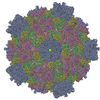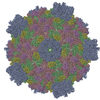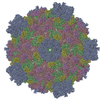+ Open data
Open data
- Basic information
Basic information
| Entry | Database: EMDB / ID: EMD-5256 | |||||||||
|---|---|---|---|---|---|---|---|---|---|---|
| Title | 3.1 Angstrom cryoEM structure of cytoplasmic polyhedrosis virus | |||||||||
 Map data Map data | This is a cryoEM density map of cytoplasmic polyhedrosis virus | |||||||||
 Sample Sample |
| |||||||||
 Keywords Keywords |  cytoplasmic polyhedrosis virus / cytoplasmic polyhedrosis virus /  3D reconstruction / 3D reconstruction /  cryoEM / full atom model cryoEM / full atom model | |||||||||
| Function / homology |  Function and homology information Function and homology information | |||||||||
| Biological species |    Bombyx mori cypovirus 1 Bombyx mori cypovirus 1 | |||||||||
| Method |  single particle reconstruction / single particle reconstruction /  cryo EM / cryo EM /  negative staining / Resolution: 3.1 Å negative staining / Resolution: 3.1 Å | |||||||||
 Authors Authors | Yu X / Ge P / Jiang J / Atanasov I / Zhou ZH | |||||||||
 Citation Citation |  Journal: Structure / Year: 2011 Journal: Structure / Year: 2011Title: Atomic model of CPV reveals the mechanism used by this single-shelled virus to economically carry out functions conserved in multishelled reoviruses. Authors: Xuekui Yu / Peng Ge / Jiansen Jiang / Ivo Atanasov / Z Hong Zhou /  Abstract: Unlike the multishelled viruses in the Reoviridae, cytoplasmic polyhedrosis virus (CPV) is single shelled, yet stable and fully capable of carrying out functions conserved within Reoviridae. Here, we ...Unlike the multishelled viruses in the Reoviridae, cytoplasmic polyhedrosis virus (CPV) is single shelled, yet stable and fully capable of carrying out functions conserved within Reoviridae. Here, we report a 3.1 Å resolution cryo electron microscopy structure of CPV and derive its atomic model, consisting of 60 turret proteins (TPs), 120 each of capsid shell proteins (CSPs) and large protrusion proteins (LPPs). Two unique segments of CSP contribute to CPV's stability: an inserted protrusion domain interacting with neighboring proteins, and an N-anchor tying up CSPs together through strong interactions such as β sheet augmentation. Without the need to interact with outer shell proteins, LPP retains only the N-terminal two-third region containing a conserved helix-barrel core and interacts exclusively with CSP. TP is also simplified, containing only domains involved in RNA capping. Our results illustrate how CPV proteins have evolved in a coordinative manner to economically carry out their conserved functions. | |||||||||
| History |
|
- Structure visualization
Structure visualization
| Movie |
 Movie viewer Movie viewer |
|---|---|
| Structure viewer | EM map:  SurfView SurfView Molmil Molmil Jmol/JSmol Jmol/JSmol |
| Supplemental images |
- Downloads & links
Downloads & links
-EMDB archive
| Map data |  emd_5256.map.gz emd_5256.map.gz | 417.5 MB |  EMDB map data format EMDB map data format | |
|---|---|---|---|---|
| Header (meta data) |  emd-5256-v30.xml emd-5256-v30.xml emd-5256.xml emd-5256.xml | 10.3 KB 10.3 KB | Display Display |  EMDB header EMDB header |
| Images |  emd_5256_1.jpg emd_5256_1.jpg | 361.7 KB | ||
| Archive directory |  http://ftp.pdbj.org/pub/emdb/structures/EMD-5256 http://ftp.pdbj.org/pub/emdb/structures/EMD-5256 ftp://ftp.pdbj.org/pub/emdb/structures/EMD-5256 ftp://ftp.pdbj.org/pub/emdb/structures/EMD-5256 | HTTPS FTP |
-Related structure data
| Related structure data |  3izxMC M: atomic model generated by this map C: citing same article ( |
|---|---|
| Similar structure data |
- Links
Links
| EMDB pages |  EMDB (EBI/PDBe) / EMDB (EBI/PDBe) /  EMDataResource EMDataResource |
|---|---|
| Related items in Molecule of the Month |
- Map
Map
| File |  Download / File: emd_5256.map.gz / Format: CCP4 / Size: 1 GB / Type: IMAGE STORED AS FLOATING POINT NUMBER (4 BYTES) Download / File: emd_5256.map.gz / Format: CCP4 / Size: 1 GB / Type: IMAGE STORED AS FLOATING POINT NUMBER (4 BYTES) | ||||||||||||||||||||||||||||||||||||||||||||||||||||||||||||||||||||
|---|---|---|---|---|---|---|---|---|---|---|---|---|---|---|---|---|---|---|---|---|---|---|---|---|---|---|---|---|---|---|---|---|---|---|---|---|---|---|---|---|---|---|---|---|---|---|---|---|---|---|---|---|---|---|---|---|---|---|---|---|---|---|---|---|---|---|---|---|---|
| Annotation | This is a cryoEM density map of cytoplasmic polyhedrosis virus | ||||||||||||||||||||||||||||||||||||||||||||||||||||||||||||||||||||
| Voxel size | X=Y=Z: 1.104 Å | ||||||||||||||||||||||||||||||||||||||||||||||||||||||||||||||||||||
| Density |
| ||||||||||||||||||||||||||||||||||||||||||||||||||||||||||||||||||||
| Symmetry | Space group: 1 | ||||||||||||||||||||||||||||||||||||||||||||||||||||||||||||||||||||
| Details | EMDB XML:
CCP4 map header:
| ||||||||||||||||||||||||||||||||||||||||||||||||||||||||||||||||||||
-Supplemental data
- Sample components
Sample components
-Entire : cytoplasmic polyhedrosis virus (CPV)
| Entire | Name: cytoplasmic polyhedrosis virus (CPV) |
|---|---|
| Components |
|
-Supramolecule #1000: cytoplasmic polyhedrosis virus (CPV)
| Supramolecule | Name: cytoplasmic polyhedrosis virus (CPV) / type: sample / ID: 1000 / Details: CPV particles were purified from polyhedra. / Oligomeric state: Icosahedral particle / Number unique components: 5 |
|---|
-Supramolecule #1: Bombyx mori cypovirus 1
| Supramolecule | Name: Bombyx mori cypovirus 1 / type: virus / ID: 1 / Name.synonym: cytoplasmic polyhedrosis virus / NCBI-ID: 110829 / Sci species name: Bombyx mori cypovirus 1 / Database: NCBI / Virus type: VIRION / Virus isolate: STRAIN / Virus enveloped: No / Virus empty: No / Syn species name: cytoplasmic polyhedrosis virus |
|---|---|
| Host (natural) | Organism:   Bombyx mori (domestic silkworm) / synonym: INVERTEBRATES Bombyx mori (domestic silkworm) / synonym: INVERTEBRATES |
| Virus shell | Shell ID: 1 / Diameter: 730 Å |
-Experimental details
-Structure determination
| Method |  negative staining, negative staining,  cryo EM cryo EM |
|---|---|
 Processing Processing |  single particle reconstruction single particle reconstruction |
| Aggregation state | particle |
- Sample preparation
Sample preparation
| Concentration | 3 mg/mL |
|---|---|
| Buffer | pH: 7.4 / Details: 10mM PBS |
| Staining | Type: NEGATIVE / Details: Sample was not stained |
| Grid | Details: holey carbon grid |
| Vitrification | Cryogen name: ETHANE / Chamber humidity: 40 % / Chamber temperature: 90 K / Instrument: OTHER / Method: Blot for 3 seconds before plunging |
- Electron microscopy
Electron microscopy
| Microscope | FEI TITAN KRIOS |
|---|---|
| Electron beam | Acceleration voltage: 300 kV / Electron source:  FIELD EMISSION GUN FIELD EMISSION GUN |
| Electron optics | Illumination mode: FLOOD BEAM / Imaging mode: BRIGHT FIELD Bright-field microscopy / Cs: 2.75 mm / Nominal defocus max: 2.5 µm / Nominal defocus min: 1.0 µm / Nominal magnification: 59000 Bright-field microscopy / Cs: 2.75 mm / Nominal defocus max: 2.5 µm / Nominal defocus min: 1.0 µm / Nominal magnification: 59000 |
| Sample stage | Specimen holder: Eucentric / Specimen holder model: OTHER |
| Temperature | Average: 90 K |
| Alignment procedure | Legacy - Astigmatism: objective lens astigmatism was corrected at 150,000 magnification Legacy - Electron beam tilt params: 0 |
| Details | Low dose |
| Date | Jul 12, 2010 |
| Image recording | Category: FILM / Film or detector model: KODAK SO-163 FILM / Digitization - Scanner: NIKON SUPER COOLSCAN 9000 / Digitization - Sampling interval: 6.35 µm / Number real images: 996 / Average electron dose: 25 e/Å2 / Bits/pixel: 16 |
| Tilt angle min | 0 |
| Tilt angle max | 0 |
| Experimental equipment |  Model: Titan Krios / Image courtesy: FEI Company |
- Image processing
Image processing
| CTF correction | Details: Each particle |
|---|---|
| Final reconstruction | Algorithm: OTHER / Resolution.type: BY AUTHOR / Resolution: 3.1 Å / Resolution method: FSC 0.143 CUT-OFF / Software - Name: IMIRS / Number images used: 28993 |
| Details | 645 micrographs that clearly showed signals beyond 6 angstrom in their spectra |
 Movie
Movie Controller
Controller











